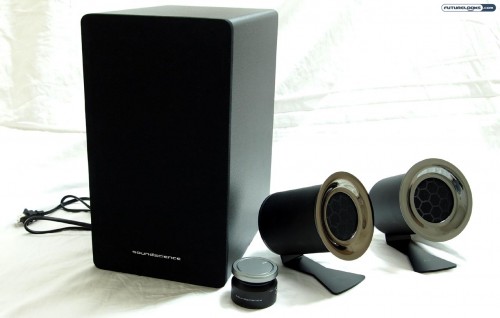
What do you do when you want the surround sound experience, but don’t exactly have the right kind of space to set up five or more speakers? Well, Antec has moved a little outside its usual area of expertise to start the new Soundscience sub-brand and the marquee product there is the Rockus 3D 2.1 speaker system.
Yes, it may only have two satellite speakers and a subwoofer, but the Rockus 3D is said to engulf you in a similar 3D audio environment as a true 5.1 or 7.1 surround sound system. Does it perform in this regard? How’s the sound quality overall? All this and more in today’s review!
Features and Specifications
So, what are some of the key features on the Rockus 3D?

The two satellite speakers are constructed with anodized aluminum, which is supposed to reduce vibration and minimize distortion. This way, you get “the clearest mids and highs.” The all metal construction offers durability and clarity. Each of the satellites offer 25 watts of juice.
The 100 watt subwoofer is where you’ll get the oomph. Instead of using a conventional sub design with a large enclosure, Soundscience uses a passive radiator design for “extended low frequency response.”

Rounding out the highlights are the 3D-tuned drivers, dual-mode operation (I’ll get to this in a moment), and a user-friendly remote control pod that lets you switch modes, change the volume, and mute the sound as needed.
The Soundscience Rockus 3D 2.1 Speakers retail for $199 US with most retailers selling for a little less. Let’s see what you get and if it’s worth the price of admission.
What’s In the Box?

Popping open the box, you get the two satellite speakers, of course, as well as the relative compact (350.5 x 195.6 x 269.2mm) subwoofer. A standard set of speaker wires are provided for the satellites, which connect back to the subwoofer as the central unit.
Along with the round control pod, there is the necessary wire for connected that pod back to the subwoofer. Finally, you get a power cord and some basic instructions, as well as a couple of audio cables to accept standard 3.5mm audio sources and RCA audio input.
Connectivity Options and Setup

Swinging around to the back of the subwoofer, we find a reasonably straightforward layout for connecting all your bits. Above the power cord, which is permanently attached to the subwoofer, you find the power switch.
In the center column are the positive and negative terminals for the left and right satellite speakers. These work like just about every other standard stereo speakers, except the end that connects to the speakers themselves is a plug rather than a pair of positive and negative wires.
And to the right (when looking from the back) are your choices for analog audio input (either via 3.5mm stereo mini or the pair of RCA inputs) and digital audio input (via TOSLINK optical). Below that is a hard switch for three levels of bass and the connector for the top controller.
